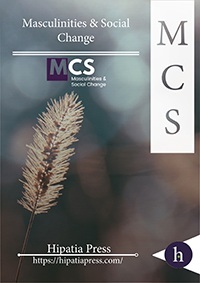Nāgaraka in the Kāmasūtra: An Introduction to Masculinity in Early India
Keywords:
Downloads
Abstract
The idea of masculinity is malleable in the Kāmasūtra. This study pinpoints the factors that build or refashion masculinity. It hinges on the economic stability or declination, and undergoes changes accordingly. This study suggests that economic declination might create a category of service providers, for instance, the veśyā, sub-Nāgaraka and the tṛtīyā prakṛti, or third nature, person who corroborate malleability and fluidity of masculinity. This study also suggests that idea of masculinity is disturbed when females enter the masculine domain of kāma-related knowledge. Overall, kāma is not exclusively concerned with masculinity.Downloads
References
Ali, D. (1998). Technologies of the self: Courtly artifice and monastic discipline in early India. Journal of the Economic & Social History of the Orient, 41(2), 159-184. https://www.jstor.org/stable/3632263
Google Scholar CrossrefAli, D. (2011). Rethinking the history of the kāma world in early India. Journal of Indian Philosophy, 39(1), 1-13.
Google Scholar CrossrefBongard-Levin, G. (1979). Ancient India. In K. Antonova, G. Bongard-Levin & G. Kotovsky (Auths.), A History of India (Book 1). Progress.
Google Scholar CrossrefBreitenberg, M. (1996). Anxious masculinity in early modern England. Cambridge University Press.
Google Scholar CrossrefConnell, R. W. (2005). Masculinities (2nd ed.). University of California Press.
Google Scholar CrossrefDoniger, W. (2003). The Kamasutra: It isn’t all about sex. The Kenyon Review, 25(1), 18-37. https://www.jstor.org/stable/4338414
Google Scholar CrossrefDoniger, W. (2007). Reading the Kamasutra: The strange & the familiar. Daedalus, 136(2), 66-78. https://www.jstor.org/stable/20028111
Google Scholar CrossrefFoxhall, L. (1998). Introduction. In L. Foxhall & J. Salmon (Eds.), Thinking men: Masculinity and its self-representation in the classical tradition (pp. 1-5). Routledge.
Google Scholar CrossrefGerlach, U. H. (1974). Effective handouts. Die Unterrichtspraxis [Teaching German], 7(1), 83-87. https://www.jstor.org/stable/3529312
Google Scholar CrossrefGheorghe, S. L. (2011). The differences between a living room & a drawing room. <https://www.homedit.com/difference-between-living-room-and-drawing-room/>
Google Scholar CrossrefGriffith, R. T. H. (Trans.). (1973). The hymns of the Ṛg Veda (Rev. ed.). Motilal Banarsidass.
Google Scholar CrossrefJha, D. N. (1998). Ancient India: In historical outline (Rev. ed.). Manohar.
Google Scholar CrossrefJohnston, M. A. (2010). “To what bawdy house doth your maister belong?”: Barbers, bawds, and vice in the early modern London barbershop. In A. Bailey & R. Hentschell (Eds.), Masculinity & the metropolis of vice, 1550-1650 (pp. 115-135). Palgrave Macmillan.
Google Scholar CrossrefKlemm, W. R. (1976). Efficiency of handout ‘skeleton’ notes in student learning. Improving College & University Teaching, 24(1), 10-12. https://www.jstor.org/stable/27564903
Google Scholar CrossrefManu. (2000). The laws of Manu (W. Doniger & B. K. Smith, Trans.). Penguin Books India.
Google Scholar CrossrefMcHugh, J. (2011). The incense trees of the land of emeralds: The exotic material culture of Kāmaśāstra. Journal of Indian Philosophy, 39(1), 63-100. https://www.jstor.org/stable/23884107
Google Scholar CrossrefRay, N. (1977-1978). Rural-urban dichotomy in Indian tradition & history. Annals of the Bhandarkar Oriental Research Institute, 58/59, 863-892. https://www.jstor.org/stable/41691756
Google Scholar CrossrefRocher, L. (1985). The Kāmasūtra: Vātsyāyana’s attitude toward dharma & dharmaśāstra. Journal of the American Oriental Society, 105(3), 521-529. https://www.jstor.org/stable/601526
Google Scholar CrossrefRoy, K. (1992). The king’s household: Structure/space in the sastric tradition. Economic & Political Weekly, 27(43/44), 55-60. https://www.jstor.org/stable/4399058
Google Scholar CrossrefSahgal, S. (2015). Situating kingship within an embryonic frame of masculinity in early India. Social Scientist, 43(11/12), 3-26. https://www.jstor.org/stable/24642382
Google Scholar CrossrefSahoo, P. C. (2010-2011). The Arthaśāstra on prostitution. Bulletin of the Deccan College Research Institute, 70/71, 359-361. https://www.jstor.org/stable/42931259
Google Scholar CrossrefSaxena, M. (2006). Ganikas in early India: Its genesis & dimensions. Social Scientist, 34(11/12), 2-17. https://www.jstor.org/stable/27644180
Google Scholar CrossrefSengupta, M. (2014). Courtesan culture in India: The transition from the devdasi to the tawaif or boijee. India International Centre Quarterly, 41(1), 124-140. https://www.jstor.org/stable/44733578
Google Scholar CrossrefShravak, L. (1999). Buddha’s rejection of the Brahmanical notion of ātman. Communication & Cognition, 32(1/2), 9-20.
Google Scholar CrossrefSingh, U. K. (2007). Immoral trafficking of girls & women in ancient India. Proceedings of the Indian History Congress, 68(1), 162-178. https://www.jstor.org/stable/44147828
Google Scholar CrossrefSingh, Y. B. (1993). Roots of the gaṇikā-culture of early India. Annals of the Bhandarkar Oriental Research Institute, 74(1/4), 181-190. https://www.jstor.org/stable/43977198
Google Scholar CrossrefSrinivasan, D. M. (2005). The Mauryan gaṇikā from Dīdārgañj (Pāṭaliputra). East & West, 55(1/4), 345-362. https://www.jstor.org/stable/29757653
Google Scholar CrossrefSternbach, L. (1951). Legal position of prostitutes according to Kauṭilya’s Arthaśāstra. Journal of the American Oriental Society, 71(1), 25-60. https://www.jstor.org/stable/595223
Google Scholar CrossrefSurebankar, S. P. (2012). Imaging courtesans: Early medieval Karnataka (9th-13th century A. D.). Proceedings of the Indian History Congress, 73, 367-371. https://www.jstor.org/stable/44156226
Google Scholar CrossrefTaylor, M. (2013). Purāṇic masculinities & transgender adventures in the garden of the goddess. International Journal of Hindu Studies, 17(2), 153-179. https://www.jstor.org/stable/24713564
Google Scholar CrossrefVātsyāyana. (1883-1925). The Kama Sutra of Vatsyayana (R. Burton, Trans.). The Hindoo Kama Shastra Society.
Google Scholar CrossrefVātsyāyana. (1994). The complete Kāma Sūtra (A. Daniélou, Trans.). Inner Traditions India.
Google Scholar CrossrefVātsyāyana. (1999). Kāmasūtram (P. Dwivedi, Trans.). Chaukhamba Surbharti Prakashan.
Google Scholar CrossrefVātsyāyana. (2002). Kamasutra: A new, complete English translation of the Sanskrit text (W. Doniger & S. Kakar, Trans. & Eds.). Oxford University Press.
Google Scholar CrossrefWalters, J. (1998). Juvenal, Satire 2: Putting male sexual deviants on show. In L. Foxhall & J. Salmon (Eds.), Thinking men: Masculinity & its self-representation in the classical tradition (pp. 148-154). Routledge.
Google Scholar CrossrefDownloads
Published
Almetric
Dimensions
How to Cite
Issue
Section
License
All articles are published under Creative Commons copyright (CC BY). Authors hold the copyright and retain publishing rights without restrictions, but authors allow anyone to download, reuse, reprint, modify, distribute, and/or copy articles as the original source is cited.















